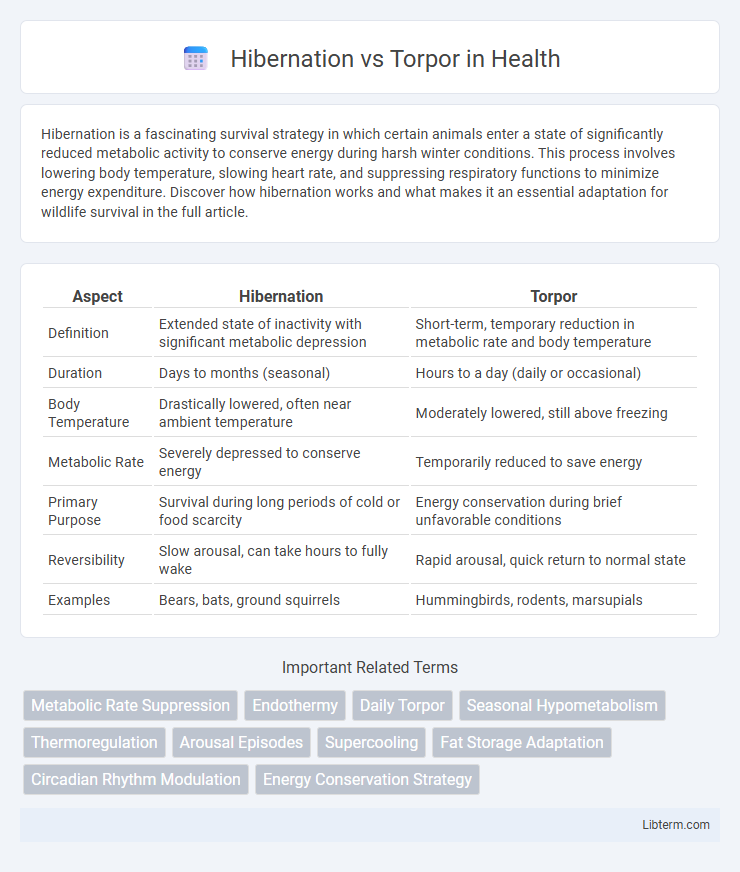Hibernation is a fascinating survival strategy in which certain animals enter a state of significantly reduced metabolic activity to conserve energy during harsh winter conditions. This process involves lowering body temperature, slowing heart rate, and suppressing respiratory functions to minimize energy expenditure. Discover how hibernation works and what makes it an essential adaptation for wildlife survival in the full article.
Table of Comparison
| Aspect | Hibernation | Torpor |
|---|---|---|
| Definition | Extended state of inactivity with significant metabolic depression | Short-term, temporary reduction in metabolic rate and body temperature |
| Duration | Days to months (seasonal) | Hours to a day (daily or occasional) |
| Body Temperature | Drastically lowered, often near ambient temperature | Moderately lowered, still above freezing |
| Metabolic Rate | Severely depressed to conserve energy | Temporarily reduced to save energy |
| Primary Purpose | Survival during long periods of cold or food scarcity | Energy conservation during brief unfavorable conditions |
| Reversibility | Slow arousal, can take hours to fully wake | Rapid arousal, quick return to normal state |
| Examples | Bears, bats, ground squirrels | Hummingbirds, rodents, marsupials |
Understanding Hibernation: Definition and Key Features
Hibernation is a prolonged state of metabolic depression characterized by significantly reduced body temperature, heart rate, and respiration to conserve energy during winter. Key features include extended duration lasting weeks or months, use by animals such as bears, bats, and ground squirrels, and reliance on stored fat reserves for sustenance. Understanding these physiological adaptations helps distinguish hibernation from shorter, less intense torpor bouts.
What is Torpor? Exploring the Basics
Torpor is a short-term physiological state in which animals drastically reduce their metabolic rate, body temperature, and energy consumption to survive periods of cold weather or food scarcity. Unlike hibernation, which lasts for weeks or months, torpor typically occurs on a daily or nightly basis, allowing animals like hummingbirds and small mammals to conserve energy without prolonged inactivity. This adaptive strategy helps maintain vital functions while minimizing energy expenditure in challenging environmental conditions.
Physiological Differences: Hibernation vs Torpor
Hibernation involves a long-term state of significantly reduced metabolic rate, body temperature, and physiological activity, allowing animals to conserve energy during winter months. Torpor is a short-term, often daily, reduction in metabolic rate and body temperature, enabling animals to cope with immediate environmental stresses such as cold or food scarcity. Physiologically, hibernation triggers profound cardiovascular and respiratory depression, while torpor induces moderate changes, facilitating quicker arousal and metabolic recovery.
Types of Animals That Hibernate
Many mammals, including bears, bats, and ground squirrels, engage in hibernation, a prolonged state of metabolic depression to survive cold winters. Hibernators typically exhibit significant drops in body temperature, heart rate, and respiration, allowing energy conservation during extended periods without food. Unlike torpor, which can occur daily in animals like hummingbirds and rodents for short-term energy savings, hibernation spans weeks or months in larger mammals.
Species That Exhibit Torpor
Species that exhibit torpor include small mammals like hummingbirds, bats, and certain rodents such as mice and hamsters, which use this short-term state to conserve energy during periods of food scarcity or cold temperatures. Unlike hibernation, torpor involves brief, daily reductions in metabolic rate, body temperature, and physiological activity, allowing these animals to quickly return to normal function when conditions improve. This adaptive strategy is crucial for survival in fluctuating environments and is commonly observed in species with high metabolic rates requiring rapid energy conservation.
Duration and Depth: Comparing Sleep States
Hibernation involves prolonged periods of deep metabolic suppression lasting days to weeks, significantly reducing body temperature and energy consumption. Torpor features shorter durations, often a few hours to overnight, with moderate decreases in metabolism and body temperature. The profound depth of hibernation contrasts with the lighter, more flexible state of torpor, allowing quicker arousal and more frequent activity cycles.
Energy Conservation: How Each Strategy Saves Resources
Hibernation significantly reduces metabolic rate and body temperature for extended periods, conserving energy by minimizing caloric needs during winter months. Torpor involves short-term metabolic suppression that allows animals to save energy daily or in response to sudden environmental stress. Both strategies optimize resource use, but hibernation enables prolonged energy conservation whereas torpor supports flexible, immediate resource management.
Environmental Triggers: What Causes Hibernation and Torpor
Hibernation is primarily triggered by prolonged exposure to cold temperatures and reduced food availability during winter, while torpor is often induced by short-term environmental stress such as sudden temperature drops or limited energy resources. Both states involve metabolic rate reduction, but hibernation occurs over extended periods, whereas torpor lasts for shorter durations, sometimes just hours or days. Photoperiod changes and ambient temperature are critical environmental cues that regulate hormonal responses initiating these energy-conservation strategies in mammals and some bird species.
Survival Advantages: Adaptive Benefits Explained
Hibernation and torpor provide crucial survival advantages by conserving energy during periods of resource scarcity or extreme cold. Hibernation enables prolonged metabolic suppression for weeks or months, allowing animals like bears and ground squirrels to endure harsh winters. Torpor, a shorter-term state seen in species such as hummingbirds and bats, offers rapid energy savings during daily temperature fluctuations, enhancing survival through reduced caloric needs.
Hibernation and Torpor in a Changing Climate
Hibernation and torpor are critical survival strategies for many species facing seasonal temperature fluctuations, with hibernation involving prolonged metabolic depression and torpor characterized by short-term energy conservation. Climate change disrupts these patterns by altering temperature cues and food availability, potentially causing mistimed hibernation and increased mortality rates. Understanding these physiological adaptations is essential for predicting species resilience and implementing effective conservation strategies in rapidly changing ecosystems.
Hibernation Infographic

 libterm.com
libterm.com